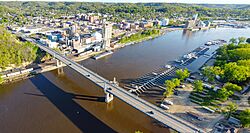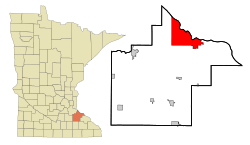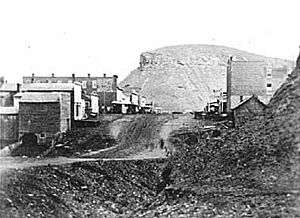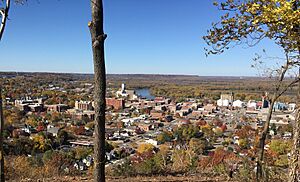Red Wing, Minnesota facts for kids
Quick facts for kids
Red Wing
|
|
|---|---|
|
City
|
|

Red Wing Bridge and Downtown Red Wing
|
|
| Motto(s):
"Come for a visit, stay for a lifetime"
|
|

|
|
| Country | United States |
| State | Minnesota |
| County | Goodhue |
| Named for | Chief Red Wing |
| Government | |
| • Type | Mayor – Council |
| Area | |
| • Total | 41.41 sq mi (107.26 km2) |
| • Land | 34.83 sq mi (90.20 km2) |
| • Water | 6.59 sq mi (17.06 km2) |
| Elevation | 735 ft (224 m) |
| Population
(2020)
|
|
| • Total | 16,547 |
| • Density | 475.12/sq mi (183.45/km2) |
| Time zone | UTC-6 (CST) |
| • Summer (DST) | UTC-5 (CDT) |
| ZIP Code |
55066
|
| Area code | 651 |
| FIPS code | 27-53620 |
| GNIS ID | 0649885 |
Red Wing is a city in Minnesota, United States. It is the main city of Goodhue County. Red Wing is located along the upper part of the Mississippi River. In 2020, about 16,547 people lived there.
The city gets its name from an important leader. He was an early 19th-century Dakota Sioux chief named Red Wing. In 1889, the government created a special area for the Mdewakanton Sioux people. This area, called an Indian reservation, is now known as the Prairie Island Indian Community. It is located along the Mississippi River, and the city of Red Wing grew up around it.
In 2008, the National Trust for Historic Preservation added Red Wing to its list of "distinctive destinations." This means the city has amazing buildings and a beautiful natural environment.
Contents
History of Red Wing
Early Settlers and Farming
In the early 1850s, people traveling on steamboats along the Mississippi River began to settle in Red Wing. They came to farm the land in Goodhue County. This land was traditionally used by the Mdewakanton Sioux people.
The new settlers cleared the land to grow wheat. Growing wheat was so profitable that it could pay for the land itself. Before railroads were built, Goodhue County grew more wheat than any other county in the country. In 1873, Red Wing was the top place for farmers to sell wheat. The city's warehouses could store and ship over a million bushels of wheat.
Later, railroads connected southern Minnesota to cities like Minneapolis. These cities had large flour mills. Because of the railroads, the port in Red Wing became less important for shipping wheat.
Skiing and Sports History
The Aurora Ski Club started in Red Wing on February 8, 1887. It was one of the first ski clubs in North America. Many people from Scandinavia, who were skilled skiers, lived in the area. In the 1880s, members of the Aurora club created a new way of skiing. It was called "Red Wing Style" and was based on Telemark skiing. This term was used in the U.S. for many years.
In 1887, a skier from Norway named Mikkjel Hemmestveit set a new record. He made the first North American ski jumping record of 37 feet at McSorley Hill. This was at the Aurora Ski Club.
Local Industries and Businesses
Red Wing's first settlers built small factories and workshops. These were similar to those they knew from New England and the upper Midwest. Many skilled workers from Germany, Ireland, Norway, and Sweden also moved to the area.
Some early businesses included tanning leather and making shoes. Other factories made farm tools, bricks, barrels, boats, furniture, pottery, and clothing buttons. They also produced beer and lumber. Services like stone-cutting, hotels, and shops were also important. The St. James Hotel is still open today and shows what the city was like long ago.
Education in Red Wing's Past
Red Wing was once home to Hamline University. It was founded in 1854 and was Minnesota's first college. However, it closed in 1869 because not enough students enrolled. Many students had left to fight in the American Civil War. The university later reopened in St. Paul in 1880.
Red Wing Seminary was a Lutheran Church school. It started in 1879 and was a learning center for the Hauge Synod, a Lutheran group. Red Wing Seminary operated until 1917.
Another school, Minnesota Elementarskola, also began in Red Wing in 1862. It was a Swedish elementary school and was the start of Gustavus Adolphus College. This college later moved to other locations.
The Pottery Industry
The Red Wing Pottery and stoneware industry began in 1861. A local potter named John Paul found large clay deposits near Hay Creek. The first company, Red Wing Stoneware, started in 1877. It used clay from the Hay Creek area. A special railroad line was built to bring the clay to Red Wing. The factory buildings are still there, but the railroad closed in 1937.
Red Wing in the 20th Century
The Minnesota Correctional Facility – Red Wing is a prison for young people. It is located in a building that was built in 1889. The building was designed by Warren B. Dunnell, a famous architect. The prison was even mentioned in a folk song by the singer Bob Dylan.
In the second half of the 20th century, the United States Army Corps of Engineers worked on the Mississippi River. They built Lock and Dam No. 3 and made the river deeper. This helped boats move more easily. As a result, more grain and coal are now shipped through Red Wing's port.
In 1973, the Prairie Island Nuclear Power Plant opened near the river. This power plant was approved by the government. Xcel Energy owns and runs the facility.
Geography of Red Wing
Red Wing covers about 41.19 square miles (107.26 square kilometers). About 34.60 square miles (90.20 square kilometers) is land, and 6.59 square miles (17.06 square kilometers) is water. The city is on the edge of the Driftless Area. This area has unique landforms made of karst topography.
Neighborhoods in Red Wing
Red Wing includes several neighborhoods and areas that have become part of the city. These include:
- Burnside Township
- East Red Wing
- Eggleston
Population of Red Wing
| Historical population | |||
|---|---|---|---|
| Census | Pop. | %± | |
| 1860 | 1,250 | — | |
| 1870 | 4,260 | 240.8% | |
| 1880 | 5,876 | 37.9% | |
| 1890 | 6,294 | 7.1% | |
| 1900 | 7,525 | 19.6% | |
| 1910 | 9,048 | 20.2% | |
| 1920 | 8,637 | −4.5% | |
| 1930 | 9,629 | 11.5% | |
| 1940 | 9,962 | 3.5% | |
| 1950 | 10,645 | 6.9% | |
| 1960 | 10,528 | −1.1% | |
| 1970 | 10,441 | −0.8% | |
| 1980 | 13,736 | 31.6% | |
| 1990 | 15,134 | 10.2% | |
| 2000 | 16,116 | 6.5% | |
| 2010 | 16,459 | 2.1% | |
| 2020 | 16,547 | 0.5% | |
| U.S. Decennial Census | |||
Population in 2010
In 2010, Red Wing had 16,459 people living in 7,017 households. About 28% of households had children under 18. Most people (91.5%) were White. Other groups included African American (1.9%), Native American (2.2%), and Asian (0.8%). About 3.7% of the population was Hispanic or Latino.
The average age in the city was 41.8 years old. About 22.5% of residents were under 18.
Economy and Businesses
Red Wing is home to several manufacturers. These include Red Wing Shoes, which makes boots and shoes. Riedell Skates makes ice and roller skates. Red Wing Stoneware continues the city's pottery tradition.
Arts and Culture
Festivals and Events
Red Wing hosts many fun events throughout the year:
- Big Turn Music Fest - February
- Prairie Island Indian Community Wacipi (Pow Wow) - July
- Rolling River Music Festival – July
- River City Days – 1st weekend in August
- Hispanic Heritage Festival – 2nd weekend in September
- MN Children's Book Festival - 3rd weekend in September
- Fall Festival of the Arts – 2nd weekend in October
- Holiday Stroll - Friday after Thanksgiving
Library Services
The Red Wing Public Library is part of Southeastern Libraries Cooperating. This means it works with other libraries in the area.
Parks and Recreation
The Cannon Valley Trail starts in Red Wing. It is a popular path for biking and walking. The nearby Prairie Island Indian Reservation has a casino and resort called Treasure Island.
He Mni Can-Barn Bluff is a natural landmark. It is a great place for hiking and rock climbing.
Media and News
Print Media
The Red Wing Republican Eagle is the local newspaper. It is published twice a week.
Radio Stations
Red Wing has two local radio stations. KCUE plays classic country music on AM radio. KWNG plays classic hits on FM radio.
Transportation
Red Wing is connected to Wisconsin by the Red Wing Bridge. This bridge is also called the Eisenhower Bridge. It carries U.S. Route 63 over the Mississippi River. Other main highways in the city include U.S. Route 61, U.S. Route 63, Minnesota State Highway 19, and Minnesota State Highway 58.
The Red Wing Regional Airport is located across the Mississippi River in Wisconsin.
Red Wing also has an Amtrak train station. The Empire Builder train stops here daily. It travels between Chicago and cities like Seattle and Portland.
Famous People from Red Wing
- Eugenie Anderson (1909–1997), a U.S. ambassador
- Tams Bixby (1855–1922), born in Red Wing, a member of the U.S. Dawes Commission
- Ryan Boldt (born 1994), a baseball player
- Joseph Francis Busch (1866–1953), a Roman Catholic bishop
- William C. Christianson (1892–1985), a Minnesota Supreme Court justice
- William J. Colvill, (1830–1905), a Civil War hero
- Frances Densmore (1867–1957), a person who studied cultures and music
- Orin Densmore (1805-1872), a Minnesota state representative
- Philip S. Duff (1922-1997), a Minnesota state senator
- Joanell Dyrstad (born 1942), a former Minnesota lieutenant governor
- Patrick Flueger (born 1983), an actor
- Mikkjel Hemmestveit (1863–1957), a skiing champion
- Torjus Hemmestveit (1860–1930), a skiing champion
- Stanley E. Hubbard (1897–1992), who started Hubbard Broadcasting
- Richard R. Lemke (1930-2016), a Minnesota state legislator
- Ned Locke (1919–1992), a TV personality
- Martin Maginnis (1841–1919), a politician and Union Army veteran
- Lyle Mehrkens (1937–2018), a Minnesota state legislator
- Lauris Norstad (1907–1988), a top military commander for NATO
- Greg Norton (born 1959), a musician from the band Hüsker Dü
- Henrietta Barclay Paist (1870–1930), an artist and teacher
- Robert Ezra Park (1864–1944), a sociologist
- Mitchell Peters (1935–2017), a percussionist
- John Pohl (born 1979), an NHL hockey player
- Trapper Schoepp (born 1990), a musician
- James Touchi-Peters (born 1956), a conductor and singer
- Theodore Swanson (1873–1959), a Wisconsin legislator
- Charles Carroll Webster (1824-1893), a lawyer and Minnesota state senator
- August Weenaas (1835–1924), the first president of Augsburg University
- Jacqueline West (born 1979), an author
- Phyllis Yes (born 1941), an artist
Sister Cities
Red Wing has special partnerships with cities in other countries. These are called sister cities:
 Ikata, Japan
Ikata, Japan Quzhou, China
Quzhou, China Kongsberg, Norway
Kongsberg, Norway
Images for kids
See also
 In Spanish: Red Wing (Minnesota) para niños
In Spanish: Red Wing (Minnesota) para niños







